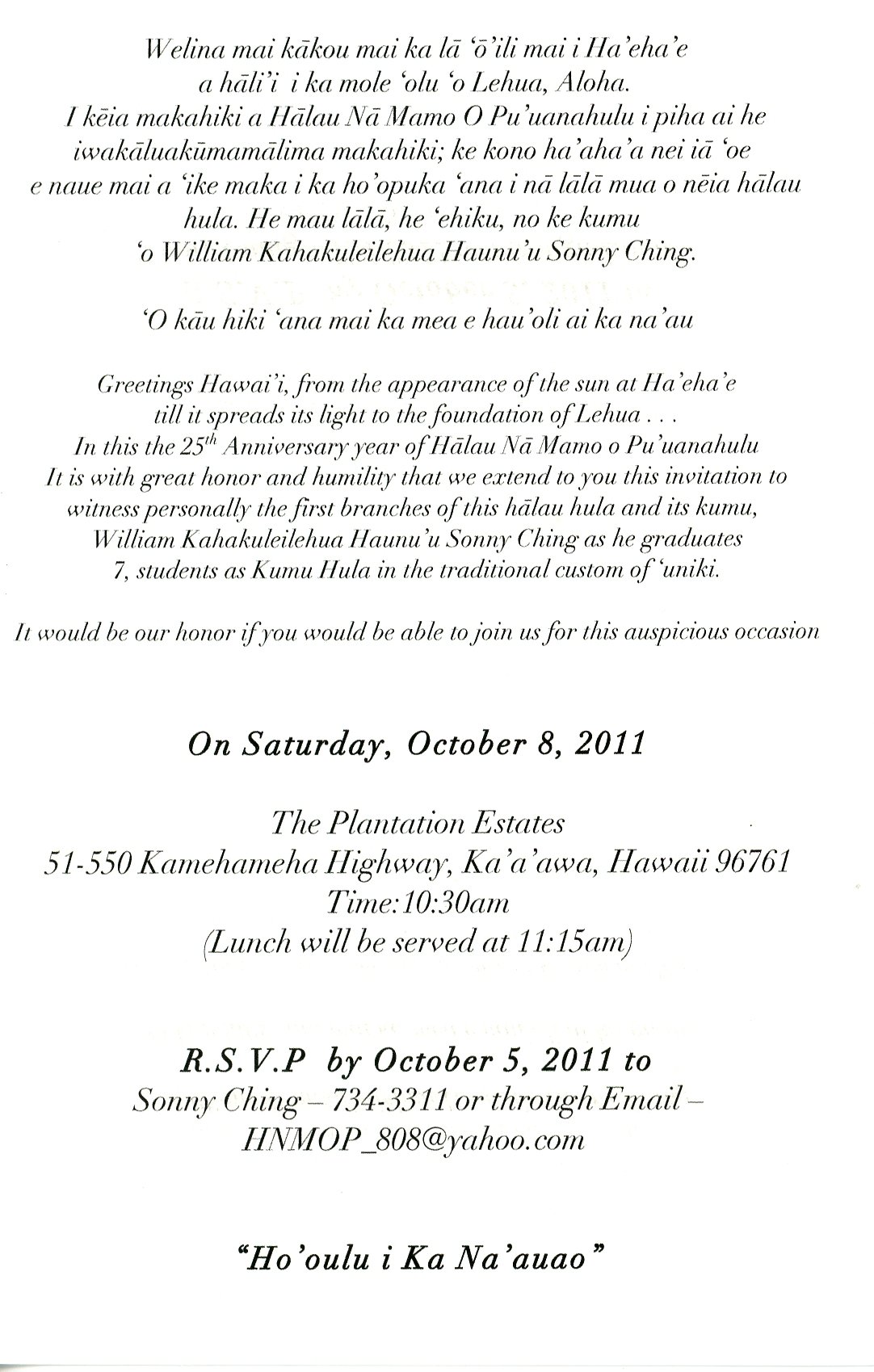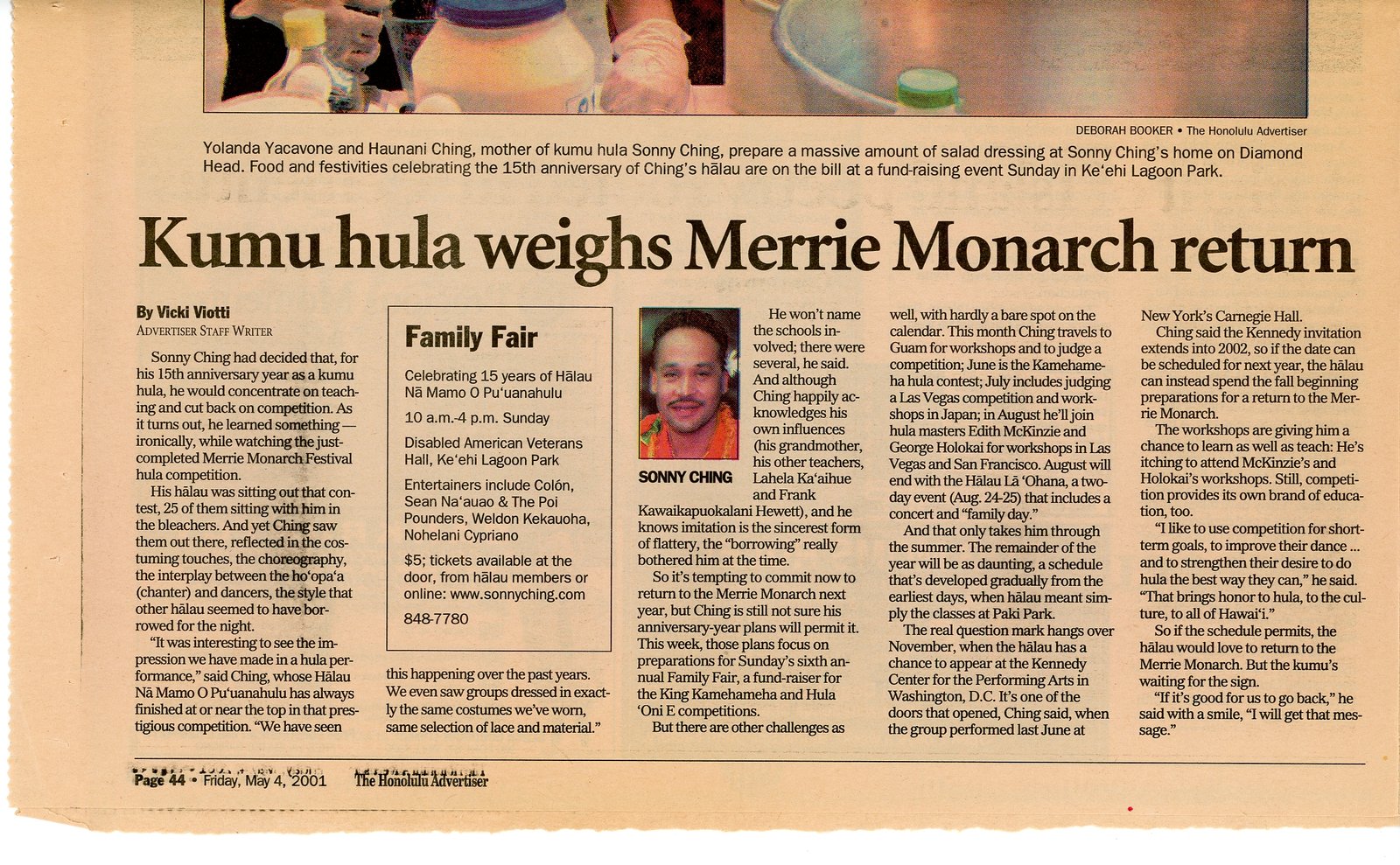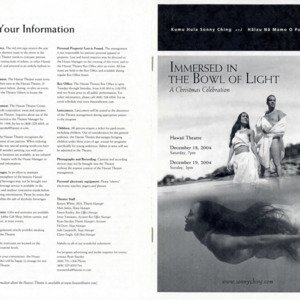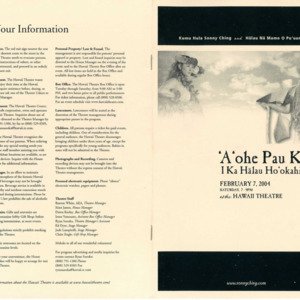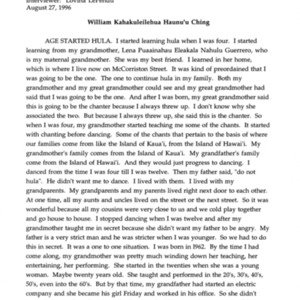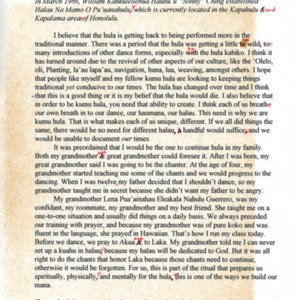William Kahakuleilehua Haunu‘u Ching
Title
William Kahakuleilehua Haunu‘u Ching
Subject
Nā Kumu Hula William Kahakuleilehua Haunu‘u Ching - Nānā I Nā Loea Hula Volume 2 Page 28
Description
In March 1986 William “Sonny" Ching established Hālau Na Mamo O Puʻuanahulu which is currently located in the Kapahulu and Kapālama areas of Honolulu.
It was preordained that I would be the one to continue hula in my family. Both my grandmother and great grandmother could foresee it. After I was born, my great grandmother said I was going to be the chanter. At the age of four my grandmother started teaching me some of the chants and we would progress to the dancing. When I was twelve, my father decided that I shouldn’t dance so my grandmother taught me without his permission. Now he is my biggest supporter.
My grandmother Lena Pua‘ainahau Eleakala Nahulu Guerrero was my confidant, my roommate, my grandmother, and my best friend. She taught me on a one-to-one situation and we usually did things on a daily basis. We always preceded our training with prayer and because my grandmother was of pure koko and was fluent in the language, she prayed in Hawaiian. That’s how I run my class today. Before we dance, we pray to Akua and to Laka. My grandmother told me I can never set up a kuahu because my hālau is to be dedicated to God. But it was all right to do the chants that honor Laka because those chants need to continue otherwise it would be forgotten. For us this is part of the ritual that prepares us spiritually, physically, and mentally for the hula. This is one of the ways we build our mana.
The method that my grandmother used to teach me hula and chant was by imitation. This is also the way I teach today. We just repeated this process until she felt I was doing ii correctly. She chanted, I chanted. She danced, I danced. I was not allowed to write anything which was good because when you learn strictly through memory, things tend to stay with you longer.
I had an ‘ūniki with my grandmother in February of 1984. It wasn’t a traditional ʻailolo ceremony but more like a hu‘elepo. It was a private ritual of prayers and food and was held during the day. I was presented and I danced and chanted some of the things I was taught. I don’t think my grandmother felt that I was truly ready to ‘ūniki but she knew that her time was ending and she felt it was necessary to do this. She even told me that though I received her permission to teach that it didn’t mean I was through learning. That for everything I knew, there was a hundred other things I didn’t know! And that I was to go on seeking knowledge. Thus the saving in our hālau, “Ho‘oulu i ka na‘auao” (To grow in wisdom).
When I was fifteen, my grandmother gave me permission to experience being in a hālau. That was my beginning with Frank Kawaikapuokalani Hewett. It was incredible to belong to his hālau. The mana within the hālau was and is very strong and you could feel the spirit permeate the air. The students had so much aloha for each other and they were so willing to spend extra time to help you learn.
I was never one of his best students. I know that I did not get enough of all he had to offer. He has so much knowledge of the culture; his whole lifestyle lives the culture. This is probably the greatest lesson I have learned from him. Becoming a kumu hula doesn’t mean you just teach hula. Becoming and being a kumu hula dictates your whole lifestyle. It dictates the way you think, your actions, and your view on life. All of these things are interrelated.
I danced with Frank for about three years and it was he who gave me the name I use today, Kahakuleilehua. After moving to town however it just became too difficult to continue commuting to He‘eia on the bus with all of my hula implements and my other interests started playing more of an important role in my life. I guess that I did not have the dedication, discipline, and desire strong enough to continue.
After about a year and a half I started with Lahela Ka‘aihue. It was Lahela who truly taught me to love the hula ‘auana. She is such a beautiful dancer. I could sit for hours and watch her dance. The style of dancing that we do, especially the men’s ‘auana, is really Lahela.
I went through a period where I wanted to be a fashion designer in New York City. Thank God I never pursued that dream. As I got older, I realized the importance of teaching hula. In 1986 Moses Crabb asked me to take over his class at Pākī Park because he was concentrating on his kumu hula training with Robert Cazimero. I started teaching a group of kupuna and ten years later I m still at Pākī Park. Some of the kupuna in my class today are the same ladies from that original class.
For any of my students to become kumu hula, they need to be stronger in the language. They need to have a better understanding of the poetry of the chants and to understand the kaona or the hidden meaning of the chants. I require them to learn all of the kuahu chants and the dressing chants. In addition I think it is very important that kumu hula are able to choreograph, create, write, take a chant from the 1600s or 1700s and put it into hula movements today.
I cannot say that what we do is what the teachers of old would do. It is good that some hula masters perpetuated things exactly as they were taught to them. And it is through their teachings that we will always have what was from a time before us. But that is not my job. My job is to perpetuate hula in the ancient styles and not be too loud or outrageous in the kahiko movements. It needs to be done within these guidelines. You need to maintain tradition even if it is choreographed today. Most importantly a kumu needs to be strong spiritually. Kumu also means foundation or base and if the foundation is not strong, you cannot build upon it.
I believe that hula is getting back to being performed more in the traditional manner. There was a period when the hula was getting a little too wild; too many introductions of other dance forms, especially to the hula kahiko. I think it has turned around due to the revival of other aspects of our culture like the ‘ōlelo, oli, planting, la‘au lapa‘au, navigation, hūnā, lua, weaving, amongst others. I hope that people like myself and my fellow kumu hula are looking to keeping things traditional vet conducive to our times. The hula has changed over time and I think that this is a good thing or it is my belief that the hula would die. I think each of us breathe our own breath into our dance, our haumāna, our hālau. This need is why we are kumu hula. That is what makes each of us unique, different. If we did things the same, there would be no need for different hālau. A handful would suffice and we would be unable to document our times.
28 William Kahakuleilehua Haunuʻu Ching
It was preordained that I would be the one to continue hula in my family. Both my grandmother and great grandmother could foresee it. After I was born, my great grandmother said I was going to be the chanter. At the age of four my grandmother started teaching me some of the chants and we would progress to the dancing. When I was twelve, my father decided that I shouldn’t dance so my grandmother taught me without his permission. Now he is my biggest supporter.
My grandmother Lena Pua‘ainahau Eleakala Nahulu Guerrero was my confidant, my roommate, my grandmother, and my best friend. She taught me on a one-to-one situation and we usually did things on a daily basis. We always preceded our training with prayer and because my grandmother was of pure koko and was fluent in the language, she prayed in Hawaiian. That’s how I run my class today. Before we dance, we pray to Akua and to Laka. My grandmother told me I can never set up a kuahu because my hālau is to be dedicated to God. But it was all right to do the chants that honor Laka because those chants need to continue otherwise it would be forgotten. For us this is part of the ritual that prepares us spiritually, physically, and mentally for the hula. This is one of the ways we build our mana.
The method that my grandmother used to teach me hula and chant was by imitation. This is also the way I teach today. We just repeated this process until she felt I was doing ii correctly. She chanted, I chanted. She danced, I danced. I was not allowed to write anything which was good because when you learn strictly through memory, things tend to stay with you longer.
I had an ‘ūniki with my grandmother in February of 1984. It wasn’t a traditional ʻailolo ceremony but more like a hu‘elepo. It was a private ritual of prayers and food and was held during the day. I was presented and I danced and chanted some of the things I was taught. I don’t think my grandmother felt that I was truly ready to ‘ūniki but she knew that her time was ending and she felt it was necessary to do this. She even told me that though I received her permission to teach that it didn’t mean I was through learning. That for everything I knew, there was a hundred other things I didn’t know! And that I was to go on seeking knowledge. Thus the saving in our hālau, “Ho‘oulu i ka na‘auao” (To grow in wisdom).
When I was fifteen, my grandmother gave me permission to experience being in a hālau. That was my beginning with Frank Kawaikapuokalani Hewett. It was incredible to belong to his hālau. The mana within the hālau was and is very strong and you could feel the spirit permeate the air. The students had so much aloha for each other and they were so willing to spend extra time to help you learn.
I was never one of his best students. I know that I did not get enough of all he had to offer. He has so much knowledge of the culture; his whole lifestyle lives the culture. This is probably the greatest lesson I have learned from him. Becoming a kumu hula doesn’t mean you just teach hula. Becoming and being a kumu hula dictates your whole lifestyle. It dictates the way you think, your actions, and your view on life. All of these things are interrelated.
I danced with Frank for about three years and it was he who gave me the name I use today, Kahakuleilehua. After moving to town however it just became too difficult to continue commuting to He‘eia on the bus with all of my hula implements and my other interests started playing more of an important role in my life. I guess that I did not have the dedication, discipline, and desire strong enough to continue.
After about a year and a half I started with Lahela Ka‘aihue. It was Lahela who truly taught me to love the hula ‘auana. She is such a beautiful dancer. I could sit for hours and watch her dance. The style of dancing that we do, especially the men’s ‘auana, is really Lahela.
I went through a period where I wanted to be a fashion designer in New York City. Thank God I never pursued that dream. As I got older, I realized the importance of teaching hula. In 1986 Moses Crabb asked me to take over his class at Pākī Park because he was concentrating on his kumu hula training with Robert Cazimero. I started teaching a group of kupuna and ten years later I m still at Pākī Park. Some of the kupuna in my class today are the same ladies from that original class.
For any of my students to become kumu hula, they need to be stronger in the language. They need to have a better understanding of the poetry of the chants and to understand the kaona or the hidden meaning of the chants. I require them to learn all of the kuahu chants and the dressing chants. In addition I think it is very important that kumu hula are able to choreograph, create, write, take a chant from the 1600s or 1700s and put it into hula movements today.
I cannot say that what we do is what the teachers of old would do. It is good that some hula masters perpetuated things exactly as they were taught to them. And it is through their teachings that we will always have what was from a time before us. But that is not my job. My job is to perpetuate hula in the ancient styles and not be too loud or outrageous in the kahiko movements. It needs to be done within these guidelines. You need to maintain tradition even if it is choreographed today. Most importantly a kumu needs to be strong spiritually. Kumu also means foundation or base and if the foundation is not strong, you cannot build upon it.
I believe that hula is getting back to being performed more in the traditional manner. There was a period when the hula was getting a little too wild; too many introductions of other dance forms, especially to the hula kahiko. I think it has turned around due to the revival of other aspects of our culture like the ‘ōlelo, oli, planting, la‘au lapa‘au, navigation, hūnā, lua, weaving, amongst others. I hope that people like myself and my fellow kumu hula are looking to keeping things traditional vet conducive to our times. The hula has changed over time and I think that this is a good thing or it is my belief that the hula would die. I think each of us breathe our own breath into our dance, our haumāna, our hālau. This need is why we are kumu hula. That is what makes each of us unique, different. If we did things the same, there would be no need for different hālau. A handful would suffice and we would be unable to document our times.
28 William Kahakuleilehua Haunuʻu Ching
Citation
“William Kahakuleilehua Haunu‘u Ching,” Nā Kumu Hula Archive, accessed October 29, 2025, https://nakumuhula.org/archive/items/show/112.





